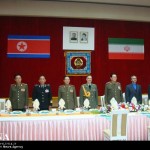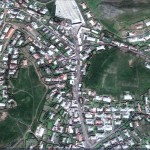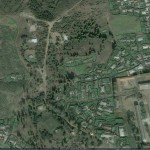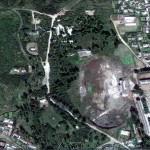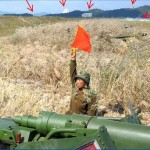UPDATE 3: NKnews.org offers a description of both missiles.
UPDATE 2 (DPRK-Iran cooperation): Arms Control Wonk has more on DPRK-Iran cooperation. The picture below would probably make Ruhollah Khomeini spin in his grave:
UPDATE 1 (Nodong Missile): Arms Control Wonk has more on a second Nodong missile that has some Iranian influences.
Aviation Week also offers a good summary:
North Korea’s weaponry is showing design characteristics associated with the Shahab 3, Iran’s most advanced missile. Such evidence is leading some international analysts to the conclusion that the ballistic missile development ties between the two countries are active and producing improvements in the arsenals of both.
While it would seem doubtful that complete missiles or missile sections are being shipped — given the close scrutiny by the West of North Korea shipping — components and engineering data could move relatively easily by air and diplomatic pouch.
For years, Iran has been the junior partner in the relationship and used the conduit to acquire No-dong and other missile technologies to build its own systems. Now, Israeli officials have noted the first public emergence in North Korea of the BM-25 Musudan, a weapon they believe has already been supplied to Iran.
It is believed to the first time the road-mobile, liquid-fueled, intermediate-range ballistic missile has been shown to anyone outside the North Korean military. The public unveiling took place Oct. 10 during a military parade attended by the country’s leader, Kim Jong-il, and his son and apparent leader-designate, Kim Jong-un.
The BM-25 is a derivative of the Russian-designed, SS-N-6 submarine-launched ballistic missile, although it has been increased in length to add range. North Korea showed several of the missile and wheeled launchers during the parade, although the operational status remains uncertain owing to a lack of flight trials detected by outside observers.
The parade also showcased a No-dong ballistic missile with a tri-conic nosecone. That configuration is typically associated with Iran’s Shahab-3, causing some analysts to suggest technical information gleaned by Tehran in flight trials is being fed to Pyongyang. Such a move would suggest Iran has made considerable progress in developing its indigenous missile engineering expertise.
The latest Iranian ballistic missile developments indicate the missiles “are much more sophisticated and reliable than the [early] Scud designs,” says Arieh Herzog, director of the Israel Missile Defense Organization. “The inertial navigation systems are better and improved guidance in the final phase makes some of them accurate to without about 100 meters.”
The migration of the BM-25 to Iran has major security implications for Europe, since it would give Tehran the ability to strike targets in southern Europe. For Israel, the introduction of the BM-25 would have relatively modest impact on its strategic calculation, since Iran already has the ability to strike Israeli cities with ballistic missiles, but it would allow Iran to disperse its launchers over a much larger area in the eastern part of the country.
ORIGINAL POST (Musudan Missile): Although Kim Jong-un stole the headlines at at the military parade, the North Korean military also reportedly paraded several new missiles. According to the AP:
Japanese public broadcaster NHK reported Sunday that the parade included three never-before-shown types of missiles and launching devices.
One was thought to be a new “Musudan” intermediate-range ballistic missile with a long, narrow head, similar to a ball-point pen, NHK said. It has a range of 3,000-to-5,000 kilometers (1,860-to-3,100 miles) and would be capable of hitting Japan and Guam, NHK said.
South Korea’s Defense Ministry said it could not immediately comment on the report. Call to South Korea’s top spy agency seeking comment went unanswered on Sunday.
Arms Control Wonk has much more.
The Choson Ilbo follows up.
Here are lots of great pictures from a Chinese site.
NTI Global Security follows up:
North Korea was reported to have unveiled three previously unseen ballistic missiles and launching apparatus during a major armed forces parade Sunday, according to the Associated Press (see GSN, March 17).
One new missile was believed to be a Musudan intermediate-range ballistic missile, which can travel 1,860 miles to 3,100 miles and could reach Guam and Japan, according to Japanese television channel NHK.
Missiles were prominently displayed at the parade with the words “Defeat the U.S. Military. U.S. soldiers are the Korean People’s Army’s enemy” written on them.
“If the U.S. imperialists and their followers infringe on our sovereignty and dignity even slightly, we will blow up the stronghold of their aggression with a merciless and righteous retaliatory strike by mobilizing all physical means, including self-defensive nuclear deterrent force,” North Korean army General Staff chief Ri Yong Ho said at the parade.
South Korean defense and intelligence officials did not offer comments on the report (Jean Lee, Associated Press/Google News, Oct. 10).
The Musudan is not known to have yet been launched in a test flight, proliferation analyst Joshua Pollack said on the website Arms Control Wonk. He cited the weapon’s flight range at roughly 1,550 miles to 1,860 miles. The missile is said to be based on the Soviet submarine-launched R-27, which is notably shorter in length than the Musudan.
The North Korean missile was initially unveiled in a 2007 armed forces parade; however, that event was closed to international media, the Chosun Ilbo reported. The South Korean newspaper reported the Musudan had a range of about 1,860 to 2,490 miles.
Evidently, some 12 Musudan missiles are fielded at missile installations in the North Hamgyong and South Pyongan provinces. The system can reportedly travel further than any other weapon in the North’s arsenal, including the Rodong missile with an 810-mile range, the newspaper reported.
“We’re looking at a new missile,” Pollack stated. “The lack of a known testing record prior to deployment raises all sorts of questions. Was it tested in another country, for example?” (Joshua Pollack, Arms Control Wonk I, Oct. 10).
The outside world also saw for the first time Sunday a new version of the medium-range Nodong ballistic missile, which was outfitted with what appeared to be a “separating re-entry vehicle,” Pollack noted.
“The question naturally arises: how long have the North Koreans had weapons of this type?” he wrote.
South Korean and U.S. news organizations initially began reporting on the Musudan missile in 2003, “so it’s certainly possible for Pyongyang to sit on these developments for years, if they wish,” he wrote.
The targeting precision of North Korean theater-range missiles such as the Nodong has been reported to have increased since July 2006 missile tests. The separating re-entry vehicle on the Nodong could explain some of that improved accuracy, Pollack stated.
Pollack indicated that details remain unclear regarding the third weapons system cited in the AP article (Joshua Pollack, Arms Control Wonk II, Oct. 10).
Read the full AP story here:
NKorea’s Kim, heir apparent son at lavish parade
Associate Press
10/9/2010
